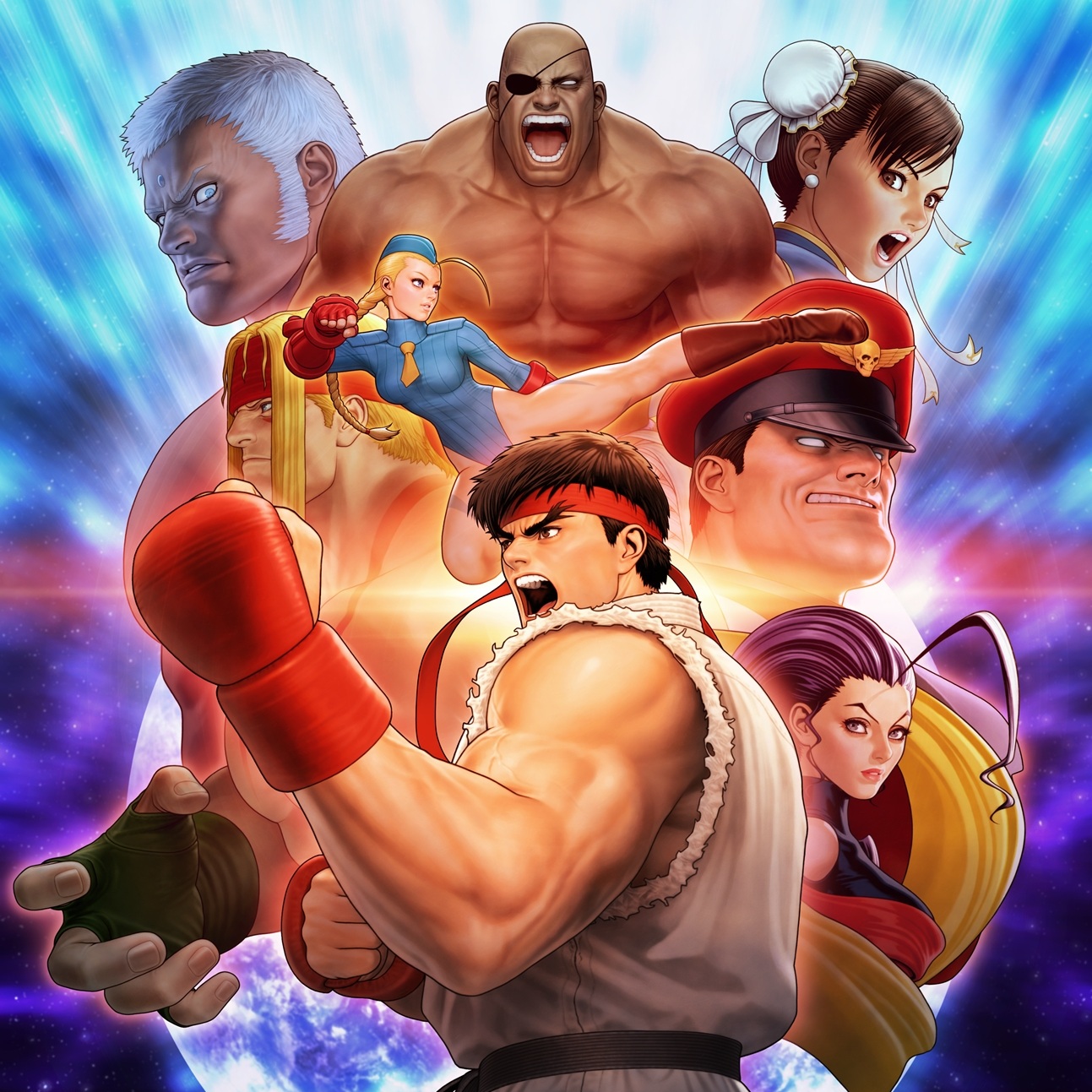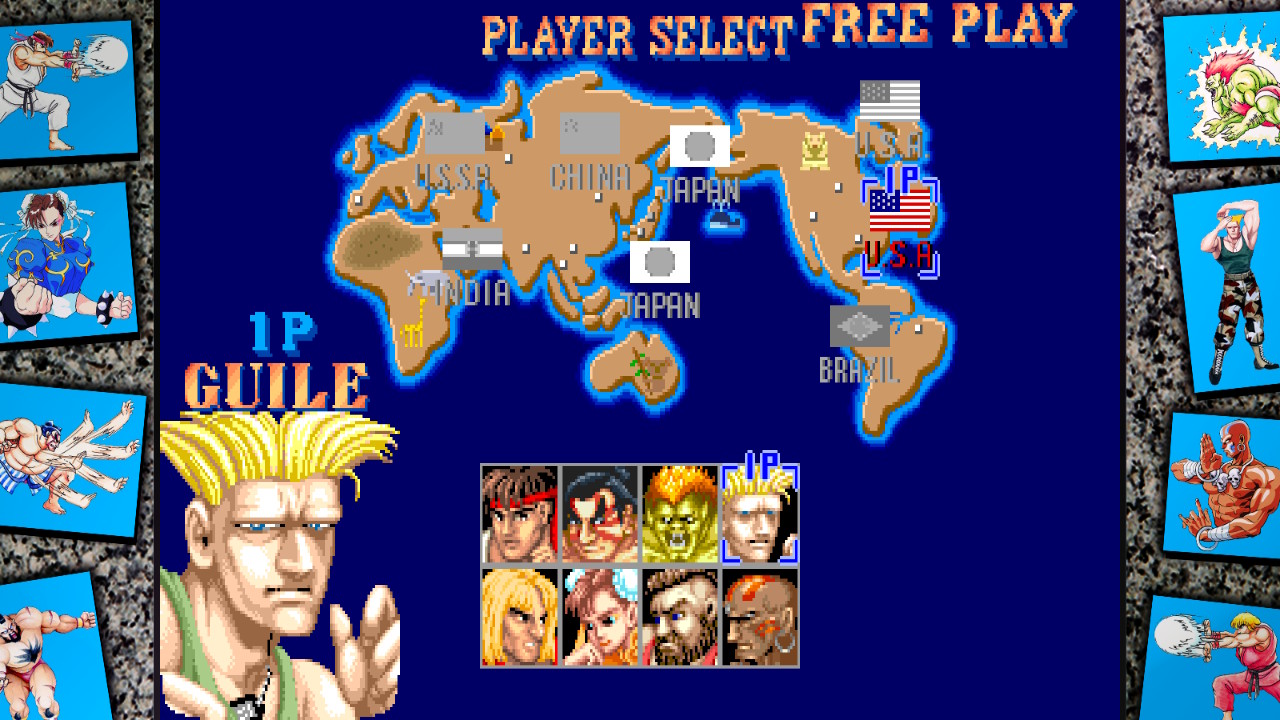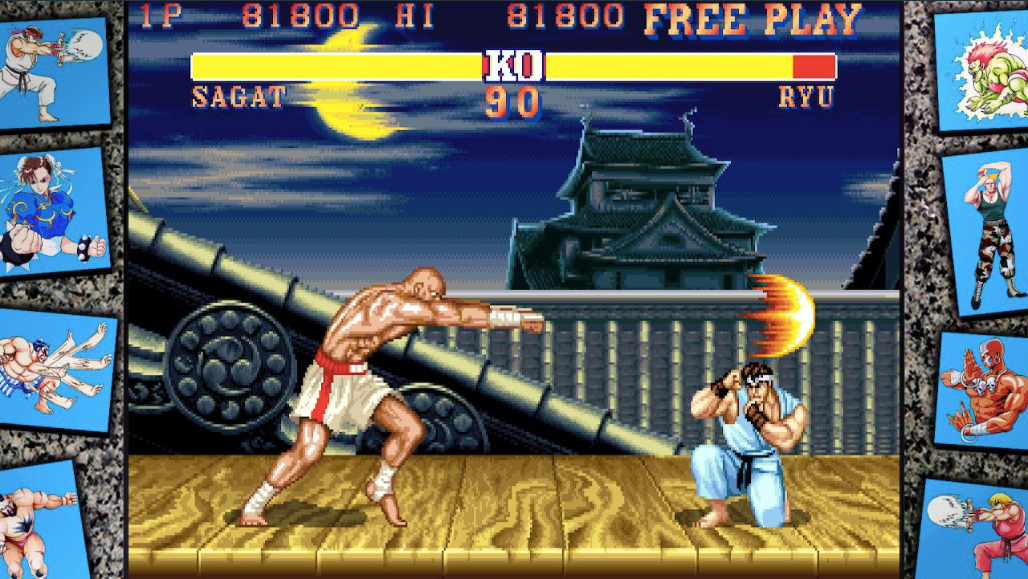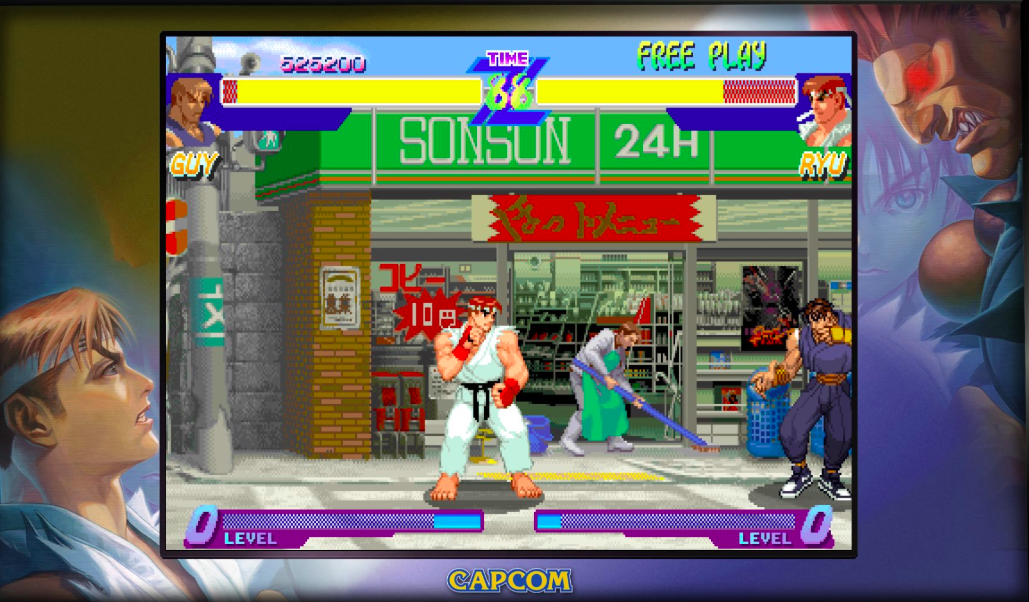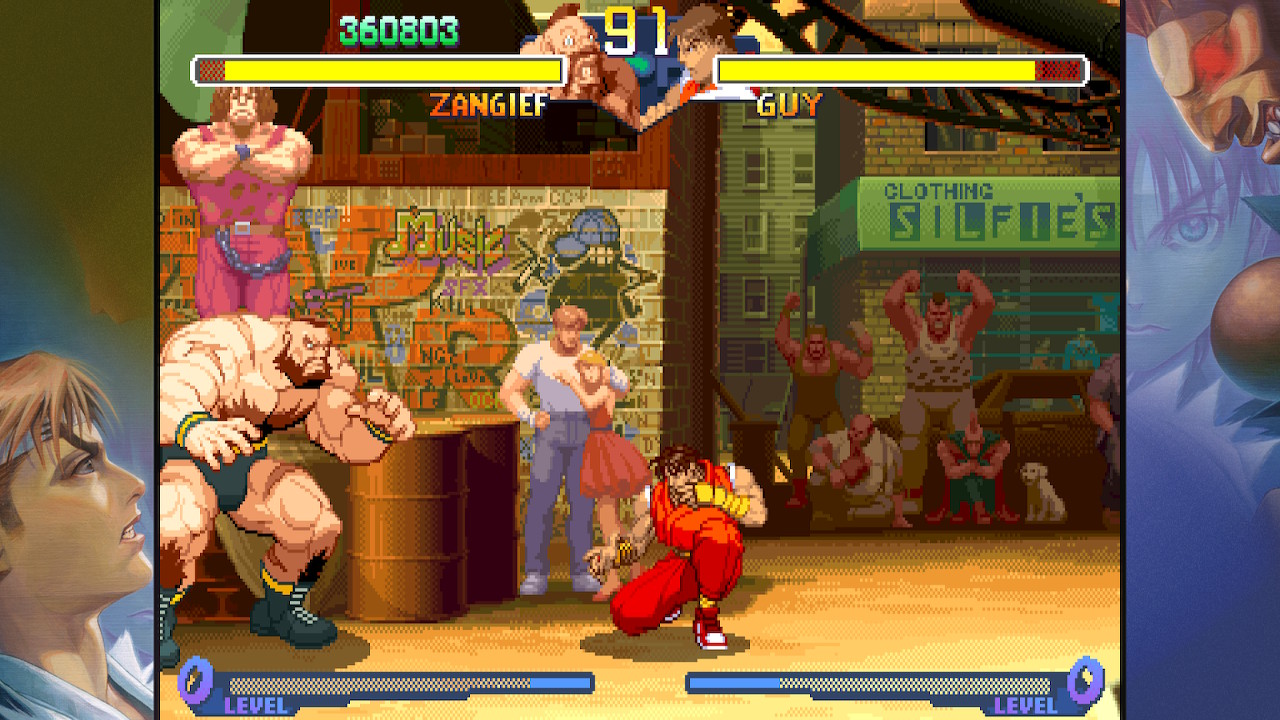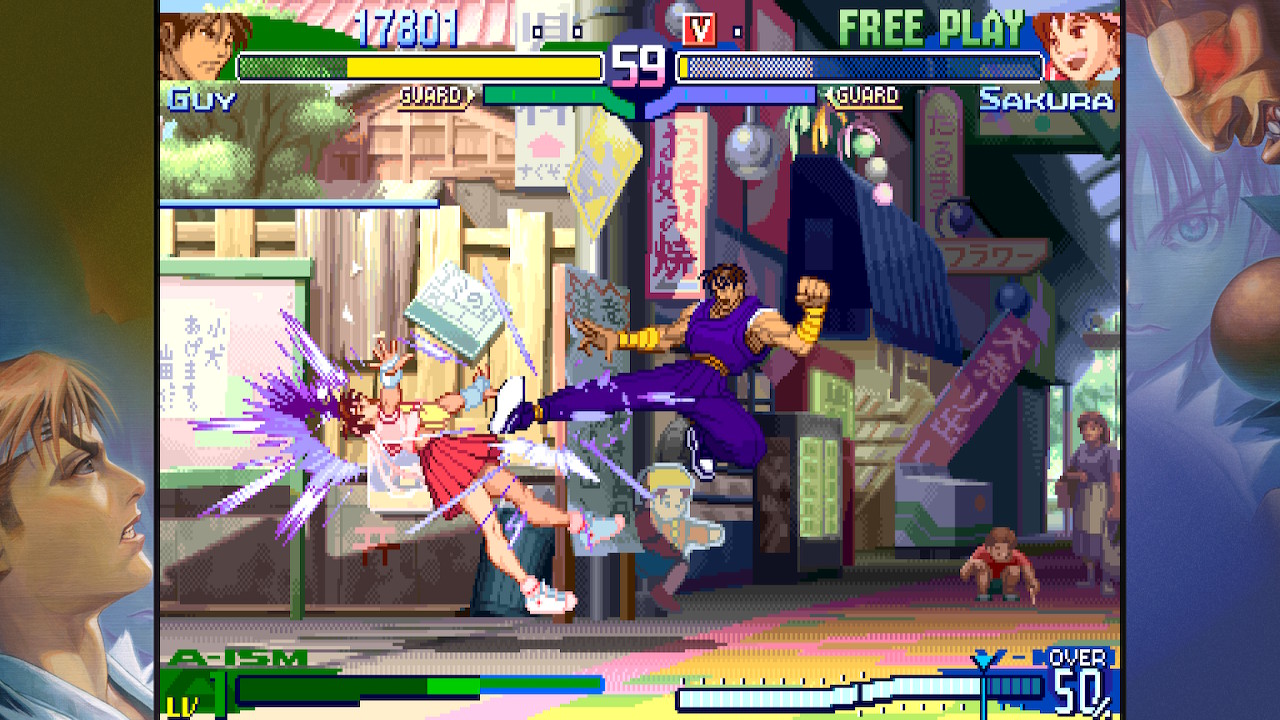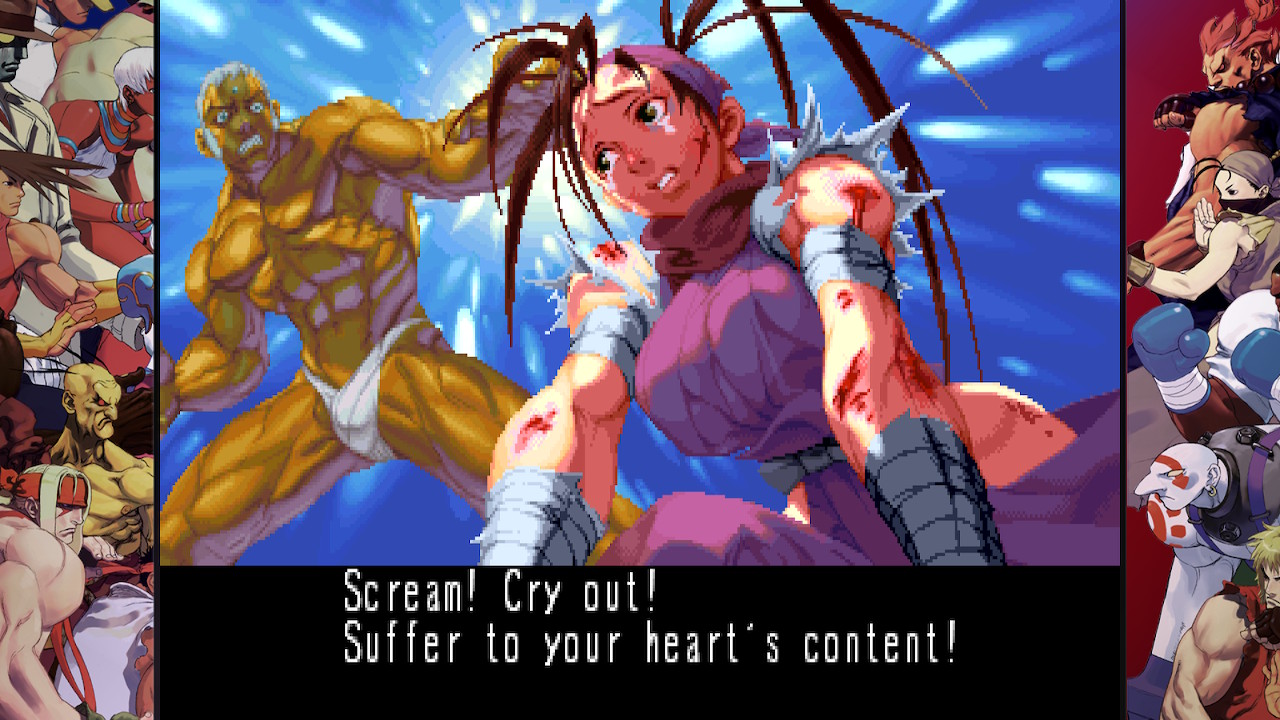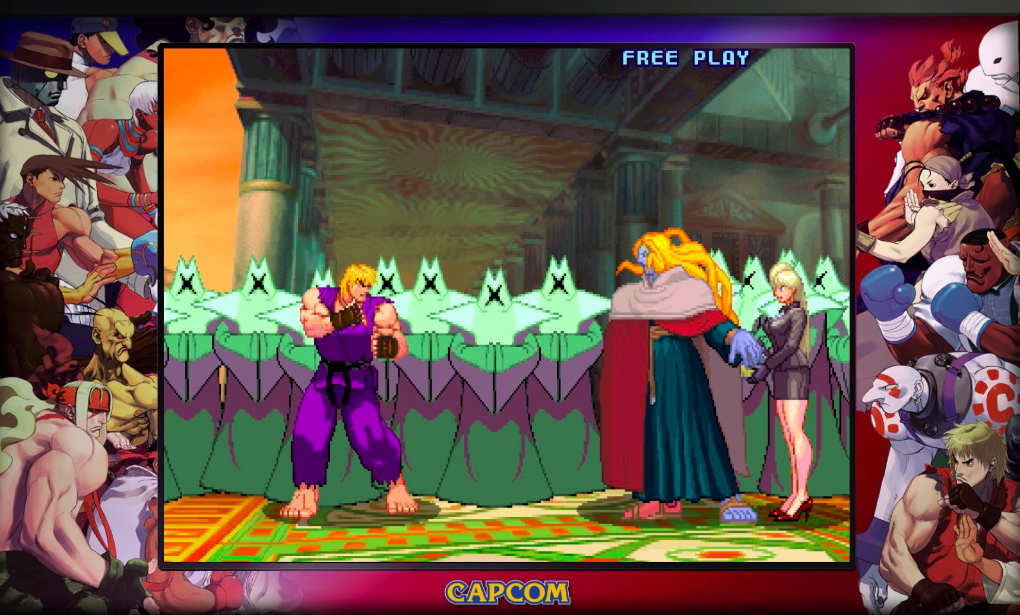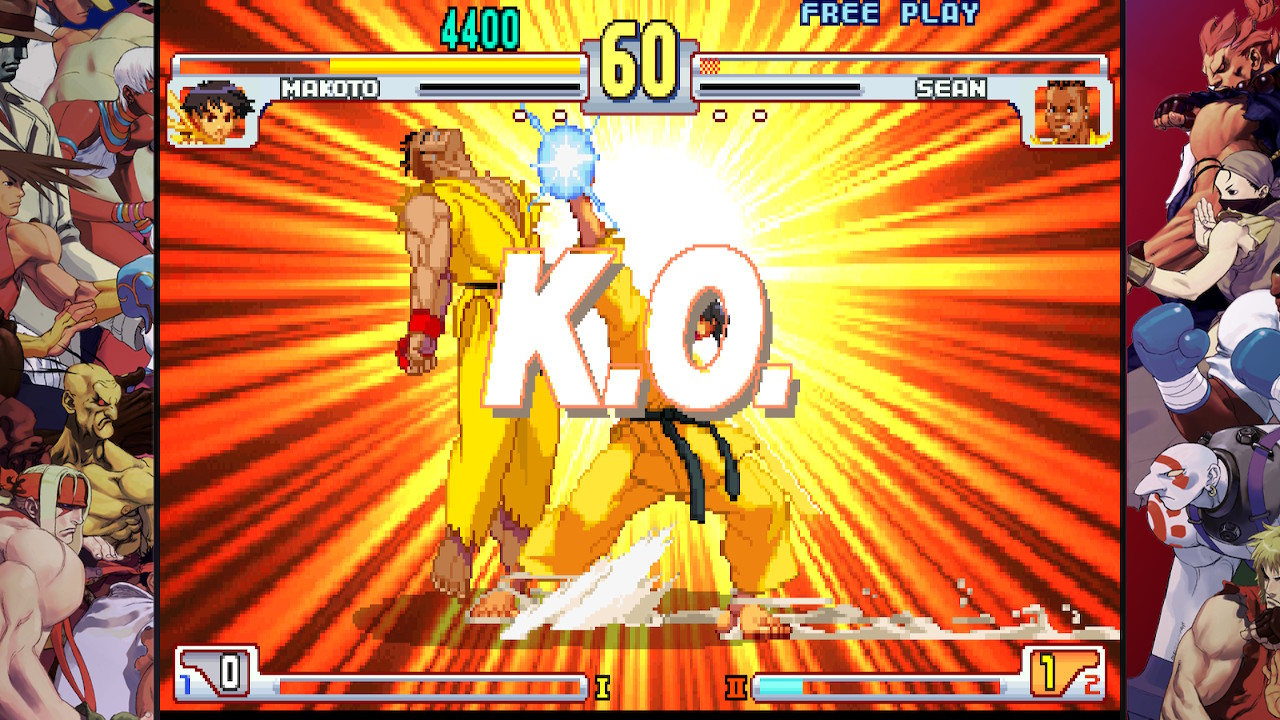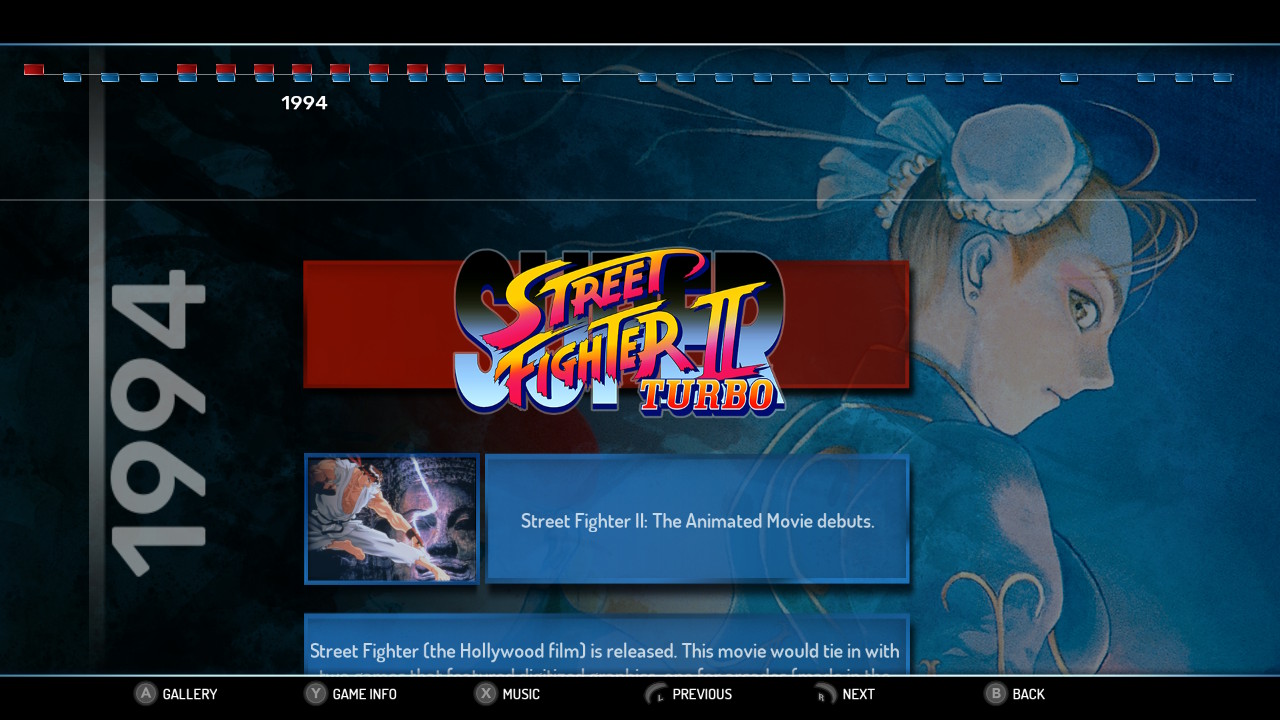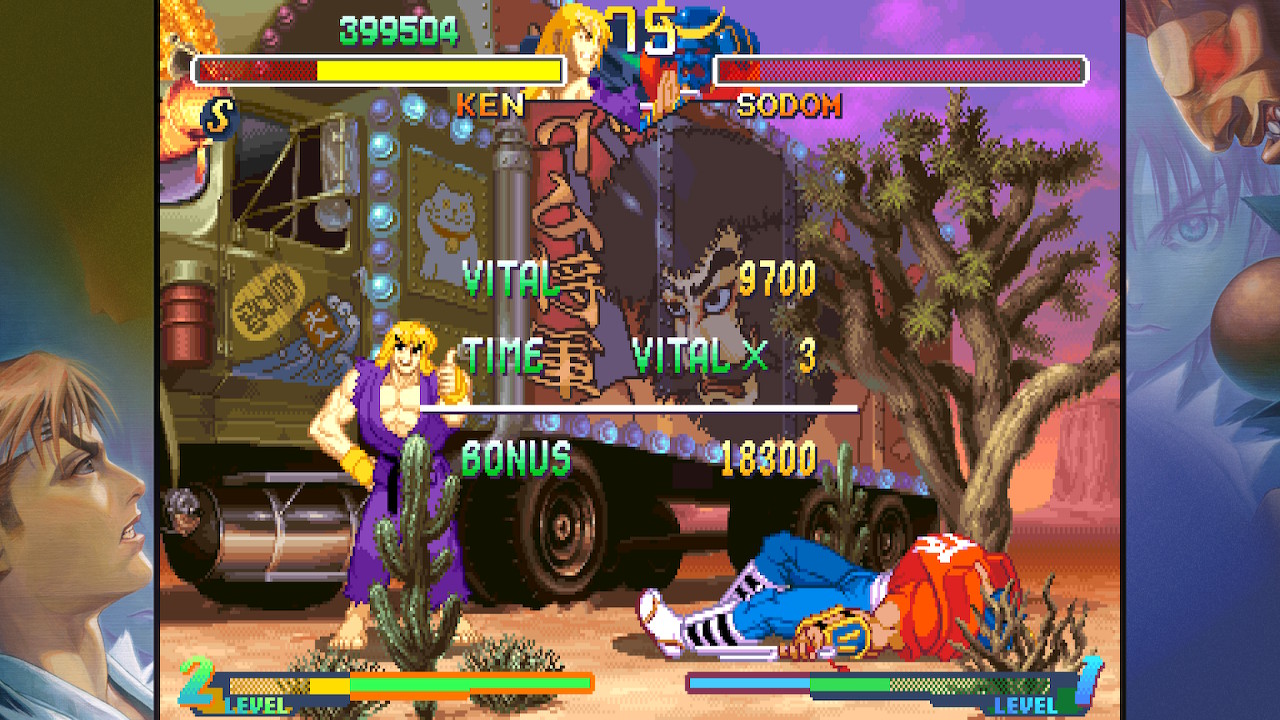Street Fighter 30th Anniversary Collection review
UPDATE: We’ve figured out a way to get multi-button mapping for this game on Switch, using macros on the 8BitDo SN30 Pro+ controller!! Check out our device review for more details.
The Kelleher Brothers were insanely pumped for the release of Street Fighter 30th Anniversary Collection. (Ok, Mike was quite interested, I was insanely pumped.) Sure, it’s merely a compilation of arcade games, something that you could have put together yourself with roms and an emulator. (And I have done that. Gotta save those classics for posterity!) But the convenience of having 12 Street Fighter games easily accessible on a modern game console, with 3rd Strike and Alpha 3 capable of online play—not to mention the huge gallery of art and archival documents of Street Fighter history—made this one a must-buy.
Hell, I bought it twice! (Once on PS4, once on Switch.)
So how does SF30th perform? How do this one compare to previous Street Fighter anthologies? (Remember the 15-year Street Fighter Anniversary Collection released on PS2 and Xbox? It had only two games: Hyper Street Fighter II and Street Fighter III: 3rd Strike, and that was pretty damn awesome. Honestly, I feel like these collections only need one game to justify their purchase: 3rd Strike. Everything else kind of seems like a bonus.)
Well, let’s address the SF30th’s biggest flaw first: there is no multi-button mapping. Each of the six arcade buttons can be mapped to your controller, but there is no option to map multiple inputs onto a single button. This means that even though you have L2 and R2 available, you cannot set them to be all three punches (LP+MP+HP) or all three kicks (LK+MK+HK).
Sakura is absolutely confounded that they left this option out.
The lack of multi-button mapping makes it considerably harder to pull off certain moves on a gamepad. It’s not just complicated techniques—like a Level-3 super combo in Alpha 1&2—that become a chore to perform. (Though, to be clear, those are now basically impossible.) EX moves in SF3 are also a lot harder to input. Hell, even just doing Zangief’s spinning lariat suddenly becomes a pain in the ass!
Arcade stick purists probably won’t even notice the omission of multi-button options. But for gamepad players—like us, Kelleher Bros—this is a staggering oversight. Honestly, it’s unforgivable.
Perhaps Digital Eclipse (the develops) left out multi-button mapping because this game is, by design, simply a compilation of arcade roms. Maybe they wanted everything—even control limitations—to remain authentic to ye olde arcade experience. Still, it’s a bad move. And as we’ll discuss later with the individual games, it is sometimes preferable to emulate the home console versions than the arcade originals.
Ok, let’s take a quick look at each game included with the collection and provide some impressions of what they have to offer….
The Games
Street Fighter (1987)
Yikes, the original Street Fighter is rough! Its primitive visuals and audio (with laughably bad voice samples) have not aged well, and this is nowhere near the quality seen in SF2…or even Final Fight, for that matter. Even if the presentation could be overlooked, the gameplay feels similarly janky and broken. While it’s touted as “where it all began”, that’s only partially true—pretty much nobody played this game. And those who did try it, surely didn’t play it for long.
Many characters introduced here return in later installments (Ryu, Ken, Sagat, Gen, Birdie, Adon), and the bonus stages in between bouts debut here as well. It’s certainly a historical artifact, and belongs in a museum, but you’re not going to spend much time actually playing it.
Verdict: Play the arcade once to say you’ve done it. But don't forget there are many guys like you all over the world!
Street Fighter II: The World Warrior (1991)
Ok, now this is “where it all began”. A classic title if ever there was one, this game single-handedly created the fighting game genre as we know it today. While these games would receive numerous upgrades and refinements along the way, the OG Street Fighter II is still an extremely playable, well-designed game.
And the roster of fighters introduced here is absolutely timeless; simply the most beloved, most iconic, most enduring cast of characters to ever grace the arcade screens. SF2’s character designs cannot be topped. Often imitated, never replicated; this set game the standard.
Verdict: You should really play through the arcade at least once. Then go home and be a family man.
Street Fighter II’: Champion Edition (1992)
The four boss characters become playable for the first time and alternate colors make mirror matches possible! SF2’s second iteration was a surefire hit back in the day, and this was the arcade machine that Mike and friends spent the most time (and quarters) playing.
Verdict: Completionists will want to give the arcade a playthrough, though casual players can give it a pass. Either way, you must defeat Sheng Long to stand a chance.
Street Fighter II’: Hyper Fighting (1992)
SF2 dials the speed up to 11 with Hyper Fighting. And it’s really amazing how fresh the game feels by cranking up the pace of the action! After you’ve played the game on Turbo, the old speed feels just slow as hell. This iteration also tweaked multiple special moves and rebalanced the characters. While this game was great in the arcades, we actually played much more of it on the Super Nintendo.
This is one of four games you can play online, so you might want to get out there and give it shot. In my experience though, it was harder to get matched up with other players for this title than it was for anything else. So good luck!
Verdict: Well worth playing the arcade—and online too, if you can find an opponent. Remember though, handsome fighters never lose a battle.
Super Street Fighter II: The New Challengers (1993)
Four new challengers enter the ring: Cammy, Fei Long, Deejay, and T. Hawk. Of all the iterations of SF2, this one is the one I personally played the most (on the SNES though) and it is honestly my favorite. The new characters fit right in with the rest of the roster, and their stages are also incredibly cool. (Cue Cammy’s theme!) Super is the game where every fighter suddenly had eight different colors to chose between, which gave you plenty of fashion options going into a fight.
The numerous palette options were actually included because Super had special Tournament Battle mode for networked arcade cabinets. And if you happen to have the Nintendo Switch version of SF30th, you can actually recreate this rare experience yourself! You simply need four Switches, each one with its own copy of the game, get everybody together in the same room, et viola, it’s tourney time! So realistically, just like the original Tournament Battle experience in arcades, you will never get to play it.
Now I would say that Super is worth playing through the arcade—and maybe even a few rounds of Versus—but unfortunately this, again, is only the arcade rom. Unlike the home console version, you cannot adjust the game speed. Luckily the default speed isn’t unbearable, but it feels really sluggish after playing Hyper Fighting or Super Turbo.
Verdict: You can pass on this one. OR you could bring two Switches (with copies of SF30th) over to Mike’s house and we’ll sit down to play Tournament Battle mode. Though in that scenario, your missing teeth will remind you of my victory!
Super Street Fighter II Turbo (1994)
As one of the other four games you can play online, you are likely to be playing Super Turbo quite a bit. Ironically though, Ultra Street Fighter II (on the Switch) might be the more accessible version of this particular game. That version actually lets you map all three punches or all three kicks to a single button, for one thing. (I am not dropping this.) It also includes extra game modes, like Buddy Battle. If I were to play a lot of SF2 online, I honestly think I’d opt for Ultra instead. (Which feels like blasphemy, now that I say it out loud, but whatever.)
Also, it’s worth noting that the this is the original arcade rom for this Super Turbo, which had a notorious glitch that made playing against the CPU crushingly/frustratingly/impossibly hard on even the lowest difficulty setting. So be forewarned, arcade mode here is straight-up broken.
Verdict: Online and Versus modes are excellent inclusions, but arcade mode sucks. Attack if you dare, it will crush you!
Street Fighter Alpha: Warriors’ Dreams (1995)
The Alpha series was my jam in the late 90’s; I seriously love these games! Unfortunately the first SFA is not necessarily that great. The anime-influenced character designs, intricate stage backgrounds, and funkalicious soundtrack are amazing as ever, but the gameplay is noticeably rough in comparison to its sequels. Set before the events of SF2, oldie characters return from SF1 (Adon, Birdie, Gen) and even a couple from Final Fight (Guy, Sodom). Younger Ryu has red hair like he did in the original game, and Guile’s deceased buddy Charlie Nash is still alive. Akuma is a hidden character here, as is Dan. Honestly though, Guy is such a badass, why would ever play as anyone else?
Verdict: I say play the arcade mode once, if only for the stage backgrounds and mushmouth announcer alone.
Street Fighter Alpha 2 (1996)
Oh man, this game is awesome—truly a nostalgia overload! Alpha 2 is honestly the game that I was most eager to play. Overshadowed by the spectacular Alpha 3, this middle child of the series is often forgotten. But in terms of style, presentation, and story, Alpha 2 is a timeless classic. Again the stage backgrounds are so rad, it’s actually a shame that none of them carry over into the next game. Gen’s dank back alley, Dan’s bustling market, Guy’s crowded Metro City, Ken’s birthday pool party: everything is so vibrant and occasionally featuring cameos from other Capcom characters. Birdie’s stage even has you fighting in a men’s room. Incredible!
Verdict: You must play through the arcade once or twice, just to take in the 90’s anime badassery.
Street Fighter Alpha 3 (1998)
SFA3 is an amazing game, undisputedly; one of the greatest fighting game of all time. Which is paradoxically why it is the single most disappointing game in this compilation.
The thing is, the home ports of Alpha 3 (like on PS1, Dreamcast, GBA, etc.) included several more fighters and featured some legitimately cool additional game modes. Again, since SF30th has the original arcade roms, all the added characters and modes are gone. That means no Guile, no Fei Long, no Evil Ryu (just to name a few), and—the biggest missed opportunity of all—no World Tour mode! I have so many fond memories of playing through World Tour mode on the PS1 version that I’ve really come to think of the home port as the definitive version of SFA3. (Plus, Fei Long is too legit to quit!) The fact that this is merely the arcade version is actually a major drawback. “Arcade perfect” sounds great and all, but if the home version is better, then it kind of sucks.
Verdict: You definitely have play this one, especially if you want to play an Alpha game online. But you’ll do so through blurry vision, as your eyes well up with tears, thinking about the majestic World Tour experience that could have been!
Street Fighter III: New Generation (1997)
Yes, SF3! Now we’re into the Kelleher Bros’ favorite series. I remember when Street Fighter III machines first hit our local arcades and my jaw hit the floor. The intricately detailed artwork moving realistically with silky smooth, insanely fluid animation...no game had ever looked this good!
And the parry system—a gameplay mechanic in which you tapped forward at the exact moment an incoming attack would hit you in order to negate its damage and allow you instantly counterattack—was both the perfect extension SF’s basic gameplay and an excellent high-risk/high-reward technique for amping up skilled play. Besides the parry innovation, SF3’s gameplay felt quite grounded and straightforward in comparison to the Alpha titles (or Capcom's Versus series!), retaining much of Super Turbo’s setup. It even made players choose one of three “Super Arts” (super combos) do use in battle.
As if that wasn’t enough, this game also gave us a literal “New Generation” of fighters; a roster of unique new combatants stepping into the ring. Only Ryu and Ken returned, while the rest of the cast were colorful, cool, occasionally super weird, and incredibly refreshing. Dudley the English gentleman boxer, Sean the hotshot karate kid following in Ken’s footsteps, Ibuki the high school student ninja—this stuff is just so, so good, you guys.
Verdict: Hell yeah, play this one first!
Street Fighter III: 2nd Impact - Giant Attack (1997)
While we played lots of New Generation in arcades, with 2nd Impact we didn’t get much opportunity to try. And that’s honestly kind of shame, because there’s good stuff here. Much like how the Alpha series used completely new stage backgrounds each game, SF3 also gives us completely new stages with each sequel.
Yun & Yang, formerly alternate sprite options for essentially the same character, get separated into two distinct fighters, each with their own movesets. (Both of the Lee brothers are dope, by the way.) Urien, a balanced version of the ridiculous end boss, Gill, joins the roster, as does Hugo, the gigantic wrestler/street thug from Final Fight. And fan favorite Akuma, now older with J. Jonah Jameson-style graying hair, also appears.
Gameplay-wise, this game introduced EX moves—keying in a special move with multiple punch/kick buttons to use a small portion of your super bar and produce a powered-up version that move, kind of like a mini super. This gave players more tactical options on how to utilize their super meter. Now if only we could only map all three punches/all three kicks to single button, these EX moves would be really easy to pull off. (Seriously, I’m never going to let this go.)
Verdict: This is one game that you could easily ignore. However, I think it’s at least worth playing to see the overall presentation and hear all the voice acting before it gets changed completely with 3rd Strike. (You do not remember Alex’s original voice, I guarantee you.)
Street Fighter III: 3rd Strike - Fight For The Future (1999)
And that brings us to the main event, the pinnacle of the series, and the single greatest fighting game ever made: 3rd Strike. I said this before, and I’ll say it again: this is Street Fighter perfection.
Going from 2nd Impact to 3rd Strike, you will notice that not only are the stage backgrounds all new, but the game’s music, the announcer, and all voice acting has been completely redone. It’s a total audio overhaul! And impressively, the new stuff is 100% better. Sure, many of us weren’t sure about the Street Fighter rap at the opening of the game back in ‘99, but literally every single one of us is onboard now. Nothing gets me pumped like this soundtrack!
SF3’s already stellar roster is rounded out by some great additions, like badass traditional karate girl Makoto, Guile-ish goth kid Remy, and international man of mystery (also probably a robot) Q. Fan favorite Chun Li returns and just owns practically everyone. In a weird move, Capcom changed Sean’s moveset quite a bit, seemingly setting him up to be an underdog character (like Dan from SFA). And in an even weirder move, the included a T-1000-style shapeshifting android called Twelve. (His animations looked slick, but this character is just so out of place in SF, it’s not cool.)
Gameplay-wise, 3rd Strike is unparalleled. This game introduced two-button throws (LP+LK), with overhead attacks performed by another two buttons (MP+MK), and taunts done with the remaining two-button combo (HP+HK). This use of low, medium, and high buttons, along with the fine-tuned balance between characters, felt like the perfect evolution of SF gameplay. Especially with the parry system, this level of refinement in 2D fighting games has never been matched.
Bonus games between bouts are also super fun in 3rd Strike, with a “Parry the Ball” game and the return of “Crush the Car”—the car this time around being an era-appropriate SUV. The end boss, Gill, is just as infuriatingly cheap and unfair here as he ever was. After so many years of tangling with his two-toned elemental ass, I kind of love to hate him.
The Kelleher Bros have played a ton of 3rd Strike over the years. First on Dreamcast, then on PS2 with the first Anniversary Collection, then the “Online Edition” on PS3, and now SF30th on Switch. We literally buy it every time it is sold, for every system possible. And if we find ourselves at an arcade that has it, we’ll still spend all our time playing it there too! Seriously, this is the best fighting game ever.
3rd Strike is, of course, one of the games you can play competitively online. And, in my opinion, it’s the one that’s most worth your time. It’s just an absolute delight, so goddamn fun to play, that it’s really just a matter of connection strength/lag that can hinder the experience.
Verdict: PLAY IT NOW. (Alright, that's cool. That's what I expected!)
Online Play
For the handful of hours I’ve played online, matchmaking has really varied wildly from game to game, and session to session. Sometimes I’d get into a match and I didn’t really notice any lag at all; everything went off without a hitch. Then the next match would be so laggy, it was basically unplayable. 3rd Strike has been been running surprisingly well at times, and Alpha 3 didn’t often seem to have too much trouble either. But again, it’s been a mixed bag.
There were also times where it took forever to be matched up with opponent. I’d be sitting there for like 5-10 minutes with nothing happening. This was especially true for Hyper Fighting, which I just eventually gave up on and picked a different game.
Once connected with another player, you’re given the option to rematch the same opponent only twice before the game boots you back the menu screen. There were a few instances where I’d wait and wait, finally get matched up with someone with a decent connection, we’d play a lag-free match, and then they would inexplicably decline the rematch, so I’d go right back waiting again.
After more time spent waiting than actually playing, I tend to call it quits. Luckily there is an “Online Arcade” option which allows you play through the arcade and be interrupted by online challengers. At least then you have something to do while you wait.
Between the PS4 and Switch versions, I found that matchmaking and online connections worked far better on PS4. While it’s easy to blame Nintendo for the poorer online experience, it’s worth noting that my PlayStation has a direct wired connection to the internet, but my Switch is only connected via wifi. Perhaps if I bought a LAN adapter for the Switch, the experience would on par with PS4. I also suspect that there are just more people playing this game online on PS4 than on Switch though, so that could factor into it.
The PS4 version also has an additional “connection strength” option where you can specify the minimum connection you want to be matched up with (on a 1-5 scale). Interestingly, I’ve found that choosing a connection strength above "3-5” means that the game will never find me an opponent. Ever. Is there really no one out there with a 4 or 5 connection that I can play against? Is it me…? Am I just a 3…?
Versus Mode
Online is cool and all, but playing locally—like in the same room, on the same screen—is our favorite SF experience. And how does SF30th measure up in that department? Actually, it’s not bad at all! Interesting, Versus mode is set up in such a way to let you switch easily between the different games in the collection.
After completing a match, the game asks if you want a Rematch. Selecting “Yes” will take you back to the character select screen for that same game—and YES, the winner of the last match is allowed to change their fighter. Selecting “No” will return you to the game select screen, allowing you to choose a different a game if you’d like. So by “Rematch”, what the game means to ask is, “Stick with this game?”
Maybe you’ll want to play a few rounds of 3rd Strike, then jump into some Alpha 2, next play a little Hyper Fighting for some old school action, perhaps throw in a bit of SF3 just for comparison sake, and then back to 3rd Strike again. This is quite easy to do.
Options like game speed, timer, and round count available from the game select menu, but you’ll really only need to adjust them once. After selecting your fighters, you can select the stage, with “Random” thankfully up front as the default option.
Not much has been done for Versus mode in terms of presentation. There are no Win/Lost stats presented at any point, for any game. Even the post-match screens—included the grade rankings from 3rd Strike—are completely gone. This makes Versus feel like little more than a hack of the arcade modes. But at least you can pick a new character after a win!
Bonus Content
In addition to 12 Street Fighter games, SF30th also contains a digital Museum filled with 30 years of Street Fighter history, including a timeline chronically major SF events spanning 31 years (1987 to 2018). This is a meticulously curated collection of artwork, facts & trivia, and even playable music from each game’s soundtrack! (You can also peruse the music in its own menu section as well.) If, while looking through the timeline, you’d like to jump into a particular game to play its arcade version, that is only one button press away.
There is also a Characters section containing profiles for every single fighter who’s playable across the included games. Here you can read up on each character’s story, likes, and dislikes to your heart’s content, along with their measurements and, of course, their blood type. There’s even an option to review each character’s sprite from every version of SF they appear in, with frame-by-frame animation breakdowns of their most iconic special moves. It’s a truly unnecessary—yet spectacular—feature, and I love it.
As if all that wasn’t enough, Digital Eclipse also included a “Making of SF” section, a treasure trove of concept sketches, design documents, and other production materials, separated by game series (SF1, SF2, SFA, and SF3). For a SF fan, the wealth of art and knowledge on display here is just staggering! And for anyone interested in game development—or maybe just art production, in general—it’s really inspiring to flip though the collection. Seriously, for the art and history alone, SF30th is well worth the price of admission.
Let’s wrap this up…
I can confidently say that Street Fighter 30th Anniversary Collection is worth its $40 price tag. For fighting game fans, this is a truly stellar collection of SF titles. The four games selected for online play are even the right choices (as certainly nobody is clamoring to go online with SF1). The arcade-perfect gameplay, now at your fingertips, is just as fun today as it was back in the 90’s. And the massive collection of SF history, art, and music is unbelievably cool. Again, I’d genuinely recommend picking this game up for the art, if nothing else.
But SF30th is not a perfect slam dunk. The fact that the developers didn’t include any multi-button mapping options is a baffling oversight. (Yep, I’m still complaining about this.) If you’re a gamepad player like I am, it can be really frustrating to deal without PUNCHx3/KICKx3 buttons. The fact that these are the original arcade roms is actually a disappointment as well. Especially for Alpha 3, since its home console versions are far superior. Versus and Training modes seem like slapdash hacks of the arcade…because they basically are…and even the Online experience can be very inconsistent, depending your preferred game, region, internet setup, etc.
Still, this is all your favorite Street Fighter games in one easily accessible package. (Well, all of them except EX, but that’s a spinoff series.) And, if you have the Switch version, this SF smorgasbord is even portable! (We can play 3rd Strike on a plane, folks!) While it might not be the end-all, be-all, only-SF-game-you’ll-ever-need-forever, SF30th actually comes pretty damn close. In fact, if they had just included multi-button mapping so we could fully utilize our controllers’ buttons, I might have called it essentially perfect.
But they didn’t.

